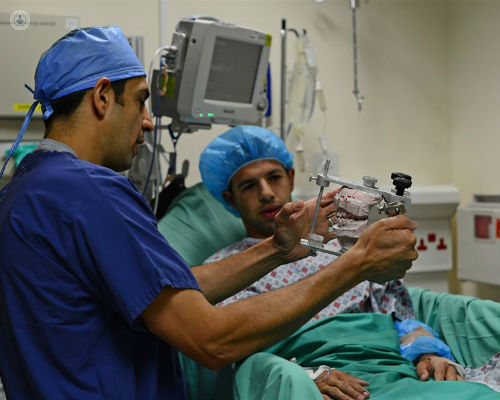Innovation in orthognathic surgery
Written by:As one of the frequent causes is the inheritance, it is important from very early on, to visit and value the children with evident signs of resembling the family. The problem is diagnosed and it is considered if the child can benefit from an orthopedic treatment to favor and stimulate the growth or a process of control during the growth is followed. If on the other hand it were decided that it would be a case that needed surgery, the ideal moment is when the jaws stop growing, in the girls over 16-18 years and in the boys over 18-20 years.
The process of treating these skeletal problems can last about two years, remember that it is a team effort between surgeon and orthodontist. It begins with a more or less long period of orthodontics, from 12 to 18 months of presurgical orthodontics, the idea is to place the teeth correctly so that the surgeon can reposition the bones with a stable occlusion.
The movement of the teeth can be done with different appliances, what should be very clear is what should be done with orthodontics and what should be done with surgery. Everything that is done with orthodontics that exceeds the limits of this, with time tends to return to its initial position. The presurgical orthodontics has the purpose of undoing the dental compensations that occur naturally to reduce the skeletal problem, so that at the end of the presurgical orthodontics phase the dental problem will have worsened, in order to obtain after the surgery, a correct position of the teeth. Orthodontics moves the teeth through periodic activations of the devices to achieve the objectives.
Preparation steps of the orthognathic case
Once the pre-surgical orthodontic objectives have been achieved, the aesthetic design and objectives of the surgery are rethought, they are discussed and accepted by the patient and surgery is scheduled. The surgery can be performed on a bone, we will call it unimaxillary surgery, which operates the maxilla or mandible or bimaxillary surgery that both bones are operated on. You can perform accessory surgeries of chin, nose, lips, cheekbones all to promote the final aesthetic. It is a painless surgery, with possible inflammation, with little time of hospital stay and initial recovery in a week and recovery of appearance in a month, the changes are totally stable in a year.
After the immediate surgery the recovery of the patient in his muscular movements begins and the postoperative orthodontic stage begins, where the occlusion and the dental esthetics are detailed. This period can last between 6-12 months. In the end, like all orthodontic treatment, retention equipment is placed to avoid these relapse movements.
A new technique of orthognathic surgery, is SURGERY FIRST, it is only a change of timing, the surgery is performed almost at the beginning, so that the preoperative orthodontic phase is almost null or minimal in time and all the orthodontic work is performed in the postoperative phase. It must be performed by a powerful team in diagnosis and management of the orthodontic technique of these cases. The planning must be exactly the same without forgetting any objective.
Technological advances in this surgical area are numerous, surgical techniques, holding miniplates, minimizing surgical time, recovery and bone recurrence. The use of digital technology, 3D records and advanced computerized guided surgery programs help to plan virtual surgery, allow greater efficiency, improve the facial diagnosis by being able to assess the 3 dimensions and help predictability.



